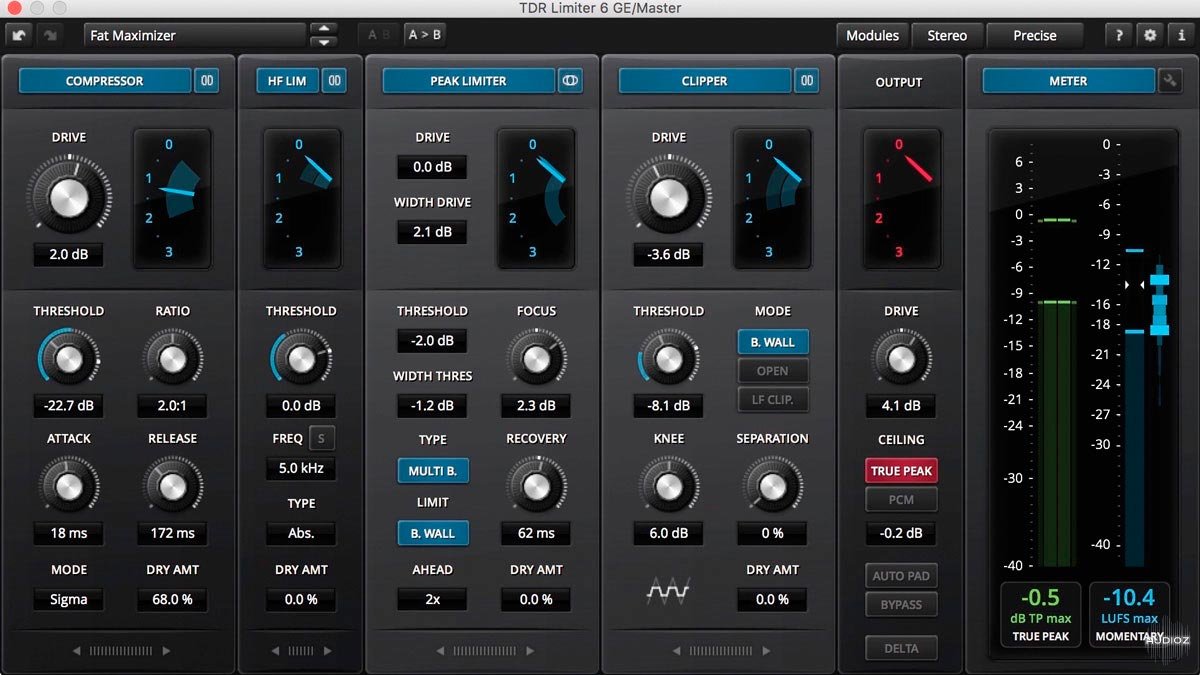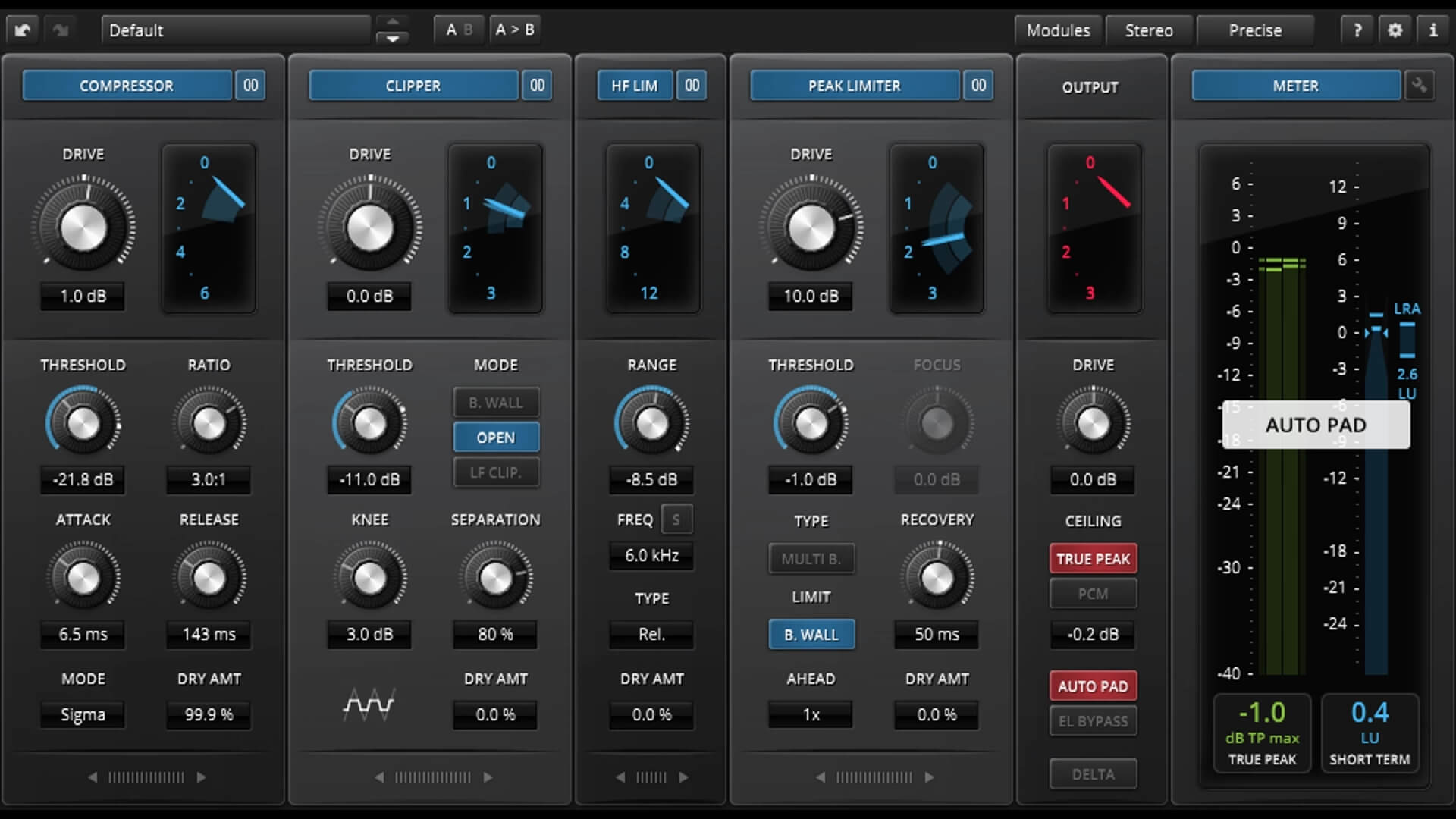Google's free service instantly translates words, phrases, and web pages between English and over 100 other languages. Yep, same problem here. New GTX660 ran fine for 3 weeks, then all of a sudden when starting BF3 it would show this message: 'display driver nvidia windows kernel mode driver version 310.90' This got progressively worse until now (a couple of days later) almost anything will trigger it. TDR sensors were set at one depth (0.01 m) at stations 1 – 4 and 6– 9; at station 5 they were set at two depths (0.01 m and 0.05 m). The curve shows the calibration equation estimated by the non. Learn and practice Aptitude questions and answers with explanation for interview, competitive examination and entrance test.
LoudMax is a Look-Ahead Brickwall Loudness Maximizer Plugin with a clean transparent sound. It is designed to retain the original character of the music as much as possible even at high compression levels.
Downloads:
VST2 Plugin v1.39 for Windows PC 32/64bit
VST3 Plugin v1.39 for Windows PC 64bit
AU/VST2/VST3 Plugins v1.39 for Mac published by PlugInGuru
LADSPA Plugin v1.39 for Linux x86 32/64bit
Winamp Plugin v1.39
Additional Releases:
AU/VST Plugins v1.39 for older Mac OS X 32/64bit (OS 10.5 - 10.14)
GUI-less VST Plugin v1.39 for Windows PC 32/64bit
Winamp Plugin v1.39 32/64bit (zipped dll)
Please note the disclaimer on the right!
Release notes v1.39:
- Support for Apple Silicon M1 processors.
- VST3 plugin available for Windows and Mac.
- Improved user interface compatibility. Meters refresh and stability issues fixed.
- Display a large user interface by clicking in the lower right corner.
- Improved algorithm.
Usage notes for VST2 / VST3 / AU:
- Hold down the Shift key to adjust the sliders more precisely.
- Click in the lower right corner to toggle the GUI size between Normal and Large. Available only if the host supports resizing. Not available in the Mac legacy version.
- The 'Fader Link' function works reliably only in the graphical user interface. In the 'generic' or 'controls' view of some DAW hosts, the link works, but the output fader change is not displayed.
- Installation instructions can be found in the readme in the zip file or through the links in the tutorials section.

- Audio Mastering
- Output Limiter/Maximizer for web radio stations

Controls:

- One slider for threshold, one for the output level
- Meters for input, output and gain reduction in relation to the desired threshold
- Link: Output slider will be coupled to the threshold slider
- ISP: Inter-sample peak detection for true peak limiting
Features:
- True Peak Limiting (Further information for ISP below)
- Supported Samplerates: 2kHz - 384kHz
- Latency: 1.25ms (+ 6 samples with ISP)
- Look-Ahead and Attack Time: 1.25ms
- Release Time: Automatic - depending on the input signal
- No audible distortion
- Possible overdrive: 740dB
- Very low CPU usage
LoudMax is available as VST 2.4 and VST 3 Plugin for Windows and Mac OS X, Audio Unit Plugin for Mac OS X, LADSPA Plugin for Linux x86 and as Winamp Plugin.
A SSE2-capable CPU is necessary (Pentium 4 / AMD Athlon 64 or newer) on Windows and Linux.
The Mac OS X Plugins are 'Universal 2 Binaries' with support for Intel Mac and ARM64 based Silicon.
The notarized Mac version was created with the friendly support of the guys from PlugInGuru.
For the users of older MAC OS a legacy version is available. The legacy Audio Unit version was built with Symbiosis from NuEdge Development.
The Linux Plugin has no meters since LADSPA doesn´t support a custom GUI. But it supports 5.1 surround modes. See README file in the LADSPA zip package for further informations.
The Winamp Plugin also supports 5.1 surround. Built-in stereo overdrive protection avoids distortions in a subsequent stereo downmix.
The Winamp Plugin has a simplified user interface. Only one slider for adjusting the maximum amplification. The maximum output level is 0dB.
The GUI was designed by LimeFlavour based on the idea and colorscheme of Sinkmusic.
Thanks to Hannes Druener for using his MacBook and testing.
Thanks to PlugInGuru for hosting the MAC files.
Inter-Sample Peak Detection:
The higher the frequency, the greater the probability that the true peak will be between two digital audio samples. These true peak overshoots can be up to 3 dB for proper band-limited audio and even much more for pathological signals. This can become a problem not only with poor D/A converters, but also with subsequent sample rate conversions, e.g. from 44.1 to 48 kHz or vice versa, and the use of audio compression such as MP3 or AAC.
For more information see the 'Tutorials' section.
When ISP is turned on, four additional samples are calculated between every two samples present. This reduces true peak overshoots for proper band-limited audio to 0.2 dB and for pathological signals to 0.5 dB.
ITU-R BS.1770: There are coefficients given in this recommendation for the calculation of inter-sample peaks. Unfortunately these coefficients do not seem to be optimal for limiters. They have a negative effect on transients and lead to high overshoots in true peak meters that use higher quality upsampling. Therefore LoudMax uses optimized coefficients that do not affect transients and reduce the overshoots to similar values with all true peak meters tested. The downside is that BS.1770 calibrated true peak meters will also detect overshoots of up to 0.2 dB with LoudMax ISP detection. So if you need to guarantee a true peak level of -1.0 dB for example, set the output level to -1.2 dB or even -1.5 dB.
Using ISP will double the CPU utilization and increase latency by 6 samples.
LoudMax changes the latency dynamically when ISP is switched. Note that most hosts do not adjust latency compensation while playing, but at the next stop/start.
This page describes timeout detection and recovery (TDR) for driver developers. See also TDR in Windows 8 and later for additional implementation details.
Overview
One of the most common stability problems in graphics occurs when a computer 'hangs', or when it appears to be completely 'frozen' while, in reality, it is processing an end-user command or operation. The user typically waits a few seconds and then decides to reboot the computer. The frozen appearance of the computer typically occurs because the GPU is busy processing intensive graphical operations, typically during game play, and hence does not update the display screen. TDRs enable the operating system to detect that the UI is not responsive.
Tdr - Limiter 6 Ge 1.1.0 Full Crackers
The figure below shows the TDR process.
The operating system (OS) attempts to detect situations in which computers appear to be 'frozen'. The OS then attempts to dynamically recover from the frozen situations so that desktops are responsive again, alleviating the situation where end users needlessly reboot their systems.
If the OS detects that six (6) or more GPU hangs and subsequent recoveries occur within one (1) minute, the OS bug-checks the computer on the next GPU hang.
Timeout detection in WDDM
The GPU scheduler, which is part of the DirectX graphics kernel subsystem (Dxgkrnl.sys), detects that the GPU is taking more than the permitted amount of time to execute a particular task. The GPU scheduler then tries to preempt this particular task. The preempt operation has a 'wait' timeout, which is the actual TDR timeout. The default timeout period in Windows Vista and later operating systems is 2 seconds. If the GPU cannot complete or preempt the current task within the TDR timeout period, the OS diagnoses that the GPU is frozen.
To prevent timeout detection from occurring, hardware vendors should ensure that graphics operations (that is, direct memory access (DMA) buffer completion) take no more than 2 seconds in end-user scenarios such as productivity and game play.
Preparation for recovery
Tdr - Limiter 6 Ge 1.1.0 Full Cracked
The GPU scheduler calls the display miniport driver's DxgkDdiResetFromTimeout function to inform the driver that the OS detected a timeout. The driver must then reinitialize itself and reset the GPU. In addition, the driver must stop accessing memory and should not access hardware. The OS and the driver collect hardware and other state information that can be useful for post-recovery diagnosis.
See TDR in Windows 8 and later for additional implementation details.
Desktop recovery
The OS resets the appropriate state of the graphics stack. The video memory manager, which is also part of Dxgkrnl.sys, purges all allocations from video memory. The display miniport driver resets the GPU hardware state. The graphics stack takes the final actions and restores the desktop to the responsive state.
The only visible artifact from the hang detection to the recovery is a screen flicker. This flicker results when the OS resets some portions of the graphics stack, which causes a screen redraw. It is eliminated if the display miniport driver complies with WDDM 1.2 and later (see Providing seamless state transitions in WDDM 1.2 and later).
When the OS has successfully recovered the desktop, it does the following:
- Displays an informational message to the end user, saying 'Display driver stopped responding and has recovered.'
- Logs the preceding message in the Event Viewer application and collects diagnosis information in the form of a debug report. If the end user opted in to provide feedback, the OS returns this debug report to Microsoft through the Online Crash Analysis (OCA) mechanism.
Some legacy DirectX applications might just render black at the end of this recovery, which requires the end user to restart these applications. Well-written DirectX 9Ex and DirectX 10 and later applications that handle Device Remove technology continue to work correctly. An application must release and then re-create its Microsoft Direct3D device and all of the device's objects.
Thread synchronization and TDR
See Thread synchronization and TDR for details.
Testing and debugging TDR
See Testing and debugging TDR for details.
Comments are closed.